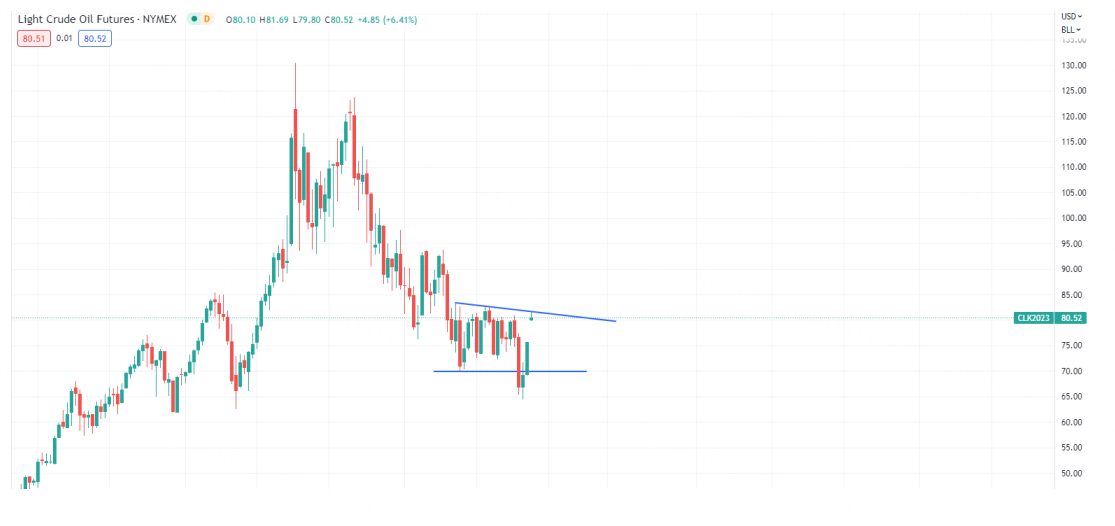What happened?
Last Sunday, OPEC+ unexpectedly announced a production cut of over 1 million barrels per day, abandoning their previous commitment to maintaining supply stability. On Monday (April 3rd), US crude oil futures opened and jumped by 8%.
Several OPEC+ members are set to tighten global production by an additional 1.16 million barrels per day until the end of the year, further burdening central bank efforts to curtail global inflation — but critically protecting the alliance’s broader output strategy from political pressures.
This unexpected cooperation among OPEC+ members surprised the market, as it was previously thought that the most likely action OPEC would take to deal with the growing uncertainty in the oil market would be to maintain existing production targets.
Oil at $100 per barrel or not?
“OPEC+‘s plan for a further production cut may push oil prices toward the $100 mark again, considering China’s reopening and Russia’s output cuts as a retaliation move against western sanctions,” CMC Markets’ analyst Tina Teng told CNBC.
In March, oil prices tumbled to their lowest since December 2021, as traders feared the banking rout could dent global economic growth.
According to @程俊Dream ‘s article, "Crude oil rose sharply on Monday, where will oil prices go in the future?" before the weekend news was released, crude oil had rebounded for two consecutive trading days. After the gap appeared, the current central price range since the end of last year has still been suppressing the rebound.
In other words, although the rebound is strong, it still belongs to a relatively standard down-break and rebound situation. Whether it can break out of the range and even return to last November's high will determine the medium-term trend of crude oil.
How to seize trading opportunities?
Trading futures is the most direct method. You can trade $Light Crude Oil - main 2305(CLmain)$ , $E-mini Crude Oil - main 2305(QMmain)$ , $Brent Last Day Financial - main 2306(BZmain)$ if you want. It is also possible to invest in crude oil ETFs and related stocks if you have not yet opened futures trading accounts.
ETFs that track crude oil
Besides futures, crude oil ETFs offer a lower risk alternative.The following are the oil-related ETF lists
$United States Oil Fund(USO)$ holds predominantly short-term NYMEX futures contracts on WTI crude oi. USO delivers its exposure to oil using near-term futures. USO gets exposure to oil using derivatives, like several oil ETPs.
$United States 12 Month Oil Fund LP(USL)$ tracks light, sweet crude oil spot prices using an average of the 12 nearest-month NYMEX WTI crude oil futures contracts.
$ProShares Ultra Bloomberg Crude Oil(UCO)$ provides 2x the daily return of an index of futures contracts of WTI crude.
$Bloomberg Crude Oil Bear 2X ETF(SCO)$ provides -2x the daily return of an index of futures contracts on light sweet crude oil.
However, when you decide to invest crude oli- related ETF, you should take care of contango. Taking USO as an example, it is ideal in terms of scale and liquidity. However, it tracks the WTI crude oil futures contract in the near month.For example, if it is currently holding a WTI futures contract expiring on April 28, it will incur losses from contango (future prices higher than spot prices) when it needs to roll over its contract. Contango is normal in the futures market, and you generally pay a premium when trading forward assets.
Therefore, when USO needs to sell the expiring contract and buy the near-term contract, it often sell low and buy high, which results in significant losses for long-term holders of such crude oil ETFs. Holding such crude oil ETFs for the long term results in significant losses.
As for leveraged ETFs, in addition to contango losses, there are also losses from daily rebalancing, making them even less suitable for long-term holding.
Energy ETFs
Unlike crude oil ETFs, energy ETFs mainly track actively managed funds that hold a basket of energy companies.
$Energy Select Sector SPDR Fund(XLE)$ XLE tracks a market-cap-weighted index of US energy companies in the S&P 500.
$Vanguard Energy ETF(VDE)$ tracks a market-cap-weighted index of US energy companies. The index includes those companies deemed investable by MSCI and covers 98% of the market.
$iShares U.S. Energy ETF(IYE)$ tracks a market-cap-weighted index of large-cap US companies in the energy industry.

Comments
Now is to let the bullets fly, completely disregard the fundamentals, just look at the chips and technical indicators can be, and technical indicators will be relatively dull, do not think that deviated immediately turn short, touch the head to be careful. Moreover, now that the money is withdrawn, it will eventually return to the stock market, with these over-the-counter chips below, the space for backtesting is very limited